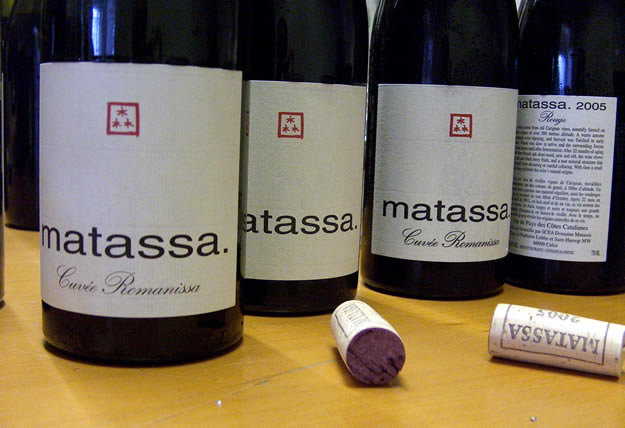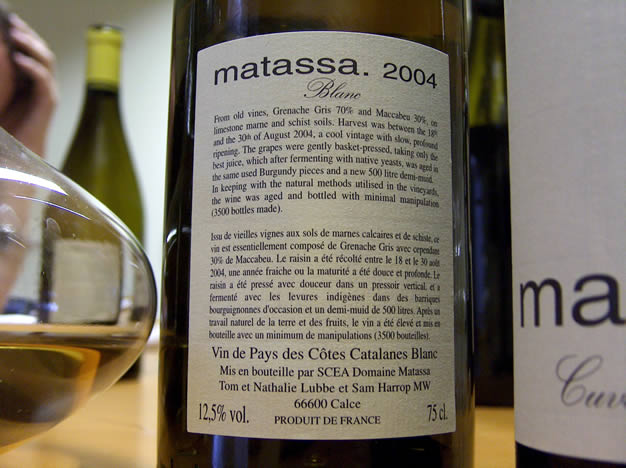|
Matassa:
an exciting Domaine from the South of France

In 2001 New Zealanders Sam Harrop and Tom Lubbe purchased a
small vineyard high up in the hills of the Coteaux du Fenouillèdes,
in the Roussillon region of France, called Clos Matassa. The
vineyard was a hillside plot planted with old-vine Carignan, and
because of the altitude, 450 metres, the growing season is around a
month longer than the lower vineyards in this warm region. Soils
are granitic.
Lubbe has experience of making wine in both France and
South Africa: I’ve reviewed his fascinating Observatory Syrah from
the Swartland region of South Africa elsewhere on this site, and
from 1999–2002 he made wine at Domaine Gauby, a celebrated estate
that’s led the way in this part of the Roussillon. Harrop is a
consultant winemaker and MW who previously worked for six years as
winemaker and buyer with the wine department at UK retailer Marks
and Spencer.
Vineyard management here employs biodynamics, and the
winemaking here is aiming to be as natural as possible. The only
addition is a bit of sulfur
dioxide,
and handling is gentle. Elevage is in a mix of 500 litre demi-muids
and 228 litre pieces, of which only a third are new. Production of
2002, the first vintage, was just 1800 bottles.
Production increased for 2003 with the purchase of 12
further vineyard plots, and from 2003 the reds have been blends of
Grenache, Mourvèdre and Carignan. They are all old vine vineyards,
with half high up in the Coteaux des Fenouillèdes and the other
half around the village of Calce, lower down (at around 150 m).
Lubbe and Harrop say that the lower vineyards contribute power
and the higher ones minerality and finesse.
I asked Sam Harrop what he thinks of biodynamics.
‘Irrespective of the wine quality’, says Harrop, ‘it has to be
good because of the way that the vineyards look, if you do a
comparison of before and after. I was originally quite cynical: I
thought it was a bit spooky’.
‘Does it matter if it works or not?’, asks Harrop.
‘When you are running a farm conventionally you spend a certain
amount of time in the vineyard. You spend more time in the vineyard
with organics, and biodynamics is one step further. The greatest
wines in the world are made where vignerons are touching fruit on a
more frequent basis, and you get improved quality from spending more
time in the vineyard.’
These are quite distinctive wines. The whites show a
bit of reductive funk, which will probably set them up for a long
life, but which some people could find a bit off-putting. The reds
are also the antithesis of the soupy, over-ripe new world style that
some in the Languedoc aim for with their more ambitious wines.
‘We want to make supple wines’, says Harrop. The
Matassa reds are picked relatively early, and show good natural
acidity. ‘It’s amazing how many people confuse acidity with
tannin’, he adds. ‘When Carignan is too ripe it loses its
definition’.
These wines are filtered. ‘I’m a big believer in filtration’,
says Harrop. ‘I’ve done trials, and in 100% of cases where a
filtered wine is compared with one not filtered, it will show better
after 6 months. The amount of microbial activity in an unfiltered
wine is huge: there’s so much going on it’s terrifying’.
Harrop adds that, ‘These days there’s no place for a wine
without filtration, particularly at this price’.
Matassa Blanc 2004 Vin de Pays des Côtes Catalanes
Lovely toasty, aromatic minerally nose is sophisticated with a
lovely reduction edge. There are minerals, some spice and some
flint. The palate is ripe and full with lovely freshness and
minerality. Striking stuff with real complexity and interest:
evolving beautifully. 93/100
Matassa Blanc 2005 Vin de Pays des Côtes Catalanes
Tight, fresh, minerally, slightly reductive nose, showing burnt
match notes with a very savoury feel to it. The palate is quite
tight and full with high acidity and a really crisp, lemony
character. Finishes nutty and broad. This is a distinctive, complex,
substantial white wine that’s quite difficult now but should age
brilliantly. 92/100
Matassa Rouge 2004 Vin de Pays des Côtes Catalanes
From higher vineyards, all of which are Carignan. Dark, smooth,
spicy nose is quite intense, but fresh with it. The palate is
savoury and fresh with lovely red fruits and a delightful savoury
structure. There’s good acidity, too. It’s a bright, fresh,
elegant style. 92/100
Matassa Romanissa 2004
Vin de Pays des Côtes Catalanes
Sweet dark fruit nose with a bit of spicy richness, and a hint
of tar. It’s a bit smoky, too. The palate is supple and fresh with
a bit of spice, and lovely rich fruit. A fine, fresh style. 91/00
Matassa Romanissa 2005 Vin de Pays des Côtes Catalanes
Lovely nose: sweet, dark, spicy and quite savoury with a hint of
tar and some smokiness. The palate has a lovely density of tight,
slightly reduced fruit with an attarctibe savoury, spicy character
and good acidity. Fresh, bright and dense with a lovely future ahead
of it. 92/100
Matassa Rouge 2005 Vin de Pays des Côtes Catalanes
Just 12.8% alcohol. A bit of flinty reduction on the nose, where
minerally dark fruits dominate. Savoury, fresh palate is tight and
focused with high acidity and red fruits joining the black. Fresh
and spicy with lovely minerality; dense but bright. Superb effort.
94/100

Wines tasted 07/07
Older notes:
Matassa 2002
With its chunky bottle and minimalist label design this looks
full of promise. It’s a concentrated red/purple colour. The nose
is quite intriguing with sweet herbs, liquorice and some butter(!).
Tight and savoury, this is quite backwards. The palate is hugely
concentrated with remarkable intensity and structure provided by
high natural acidity and firm tannins. There’s a tight core of
minerally, earthy raspberry and cherry fruit. This is currently
massively savoury and almost austere, with stunning intensity. It
will be fascinating to see how this develops, and while it is not
for everyone, I love it. Very good/excellent 93/100 (tasted twice in
2004 with consistent notes)
In November 2004
I got my first glimpse of the 2003 white. This is a profoud wine,
and every bit as good (if not better) than the red, a blend
dominated by Grenache Gris.
Matassa
Blanc 2003 Vin de Pays des Côtes Catalanes, France
Made
from old vines (mainly Grenache Gris) on limestone soil. It has
a fantastic nose: smoky, minerally and quite complex with generous
fruit. The palate is broad and dense with a smoky, minerally edge,
good acid and hints of toastiness. Sophisticated and classy. Very
good/excellent 94/100 (Adnams, c. £25) 11/04
Domaine Matassa Cuvée Romanissa 2004 Vin de Pays des Côtes
Catalanes, France
A blend of Grenache with 15% Carignan, 10% Mourvèdre and 10%
Cabernet Sauvignon. It
has a rather taut, fresh nose that isn’t giving too much away:
some spicy cherry and red berry fruit with a refined minerality, and
just a hint of roasted character. The palate has a wonderfully
tight, savoury structure with good acid and grippy, mouthfilling
tannins underpinning the delightfully fresh berry fruits. This wine
has a lovely savoury, minerally presence – despite the fact the
Roussillon is a warm-climate region that’s capable of making
super-ripe, alcoholic wines, this is a lively, bright, structured
wine that’s built to age well, but which hasn’t got an ounce of
clumsiness to it. Needs a few years in bottle to show what it’s
capable of, when the rating may well be much higher, so don’t
crack this now. Very good/excellent 92/100
02/07
Domaine
Matassa Blanc 2005 Vin de Pays des Côtes Catalanes, France
70% Grenache Gris and 30% Maccabeu, old vines, native yeasts,
old 500 litre barrels, made as naturally as possible. On opening
this shows a distinctive struck match reductive note on the nose
that’s almost overpowering. It follows through to the palate which
is reduced, savoury, spicy and minerally with a tangy finish. I
decanted it, but it was still quite reduced, showing tightwound
herbs, minerals and spice, together with some lemony freshness to
the fruit. A couple of days later it had partly emerged from this
tight-wound state to reveal a fresh, complex, strikingly mineralic
white wine of real interest. I reckon this is one to cellar for a
few years; it’s just too angular and reduced for current
consumption. But if it develops as expected, in the way a very fine
white Burgundy would, this score, based on current showing, should
rise considerably. Very good/excellent 90/100 02/07
Back
to top
|


